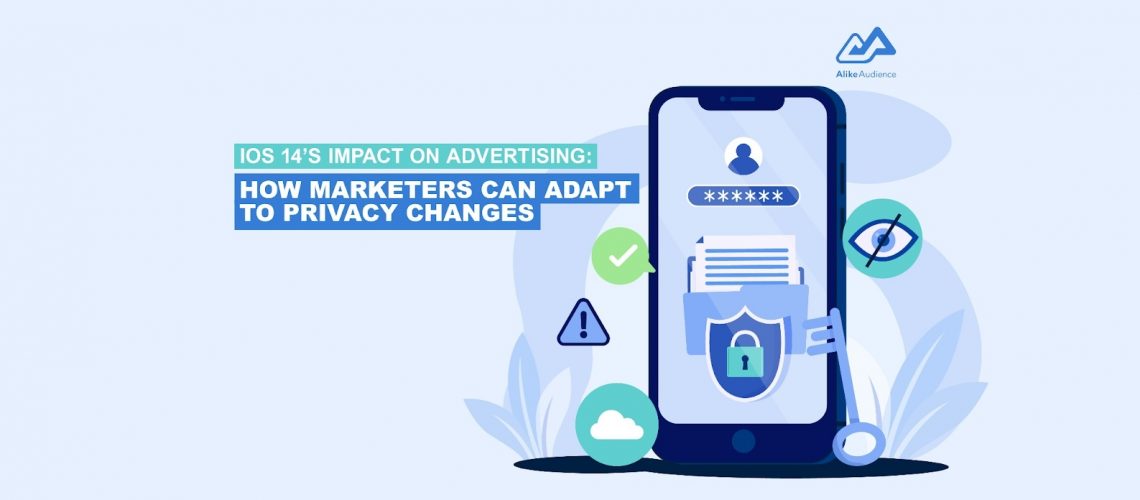For years, digital marketers have long relied on the Identifier for Advertisers (IDFA), a random device identifier assigned by Apple to a user’s device, to help pinpoint potential customers for their ad campaigns.
That all changed in 2020 with the rollout of the highly-anticipated iOS 14 and iOS 14.5 operating systems.
While there has been plenty of excitement among avid consumers about Apple’s iOS 14 user features, the updates have since caused apprehension among digital marketers due to their significant impact on data tracking in the programmatic advertising landscape.
In this post, we dive into the controversial changes of Apple’s iOS 14 updates, its impact on the marketing landscape, what to expect in the future, and strategies for programmatic advertisers to adjust their digital marketing strategy.
iOS 14 Impact on Advertising: What was the privacy update?

In September 2020, Apple began rolling out its iOS 14 operating system to iPhones across the world, with iOS 14.5 following not long after in April. But just less than a month after its release, one report indicated that 96% of U.S. users had opted out of having their actions tracked by social media platforms like Facebook.
Apple’s iOS 14 and iOS 14.5 announcements signaled the beginning of stringent new restrictions surrounding data privacy and user tracking, greatly affecting the ways in which digital advertisers reach their target audiences.
With iOS 14, Apple requires explicit permission for apps to collect and share consumer data.
But while iPhone users already had the choice to opt-out prior to iOS 14, the updated operating system began displaying an opt-in box when people first launch an app. Users can have their data and behavior tracked by tapping the “Allow” button, or opt-out by selecting the “Ask App Not to Track” option. They can also deny tracking for all apps by going to their iOS privacy settings.
To collect permission, Apple has enforced App Tracking Transparency (ATT) in the App Store, which is tied to a string of randomized numbers known as the Identifier for Advertisers (IDFA). Digital marketers have long used IDFA for attribution and tracking user data to deliver customized advertising without revealing Personally Identifiable Information (PII).
Industry commentators and experts have estimated that the majority of users will be less willing to share data and decide not to opt-in – with only 10-20% of users expected opt-in to IDFA tracking.
But how have iOS updates affected the ad tech industry, particularly programmatic advertisers’ ability to effectively reach, understand and engage with potential customers?
Related: What is Data Quality and Why Is It Important for Programmatic Advertisers?
What does this mean for digital advertising?

More than a year since the updates came into effect, advertisers are unable to easily identify and target potential customers for their ads the way they did before.
With the majority of iOS device users currently opting out of having their personal data tracked, the update has impacted social media giants such as Facebook in three main areas, including:
1. Less effective audience targeting: Before iOS 14 and 14.5, audience retargeting and lookalike modeling were both extremely effective methods in ensuring ads were placed in front of high-intent users and shown to those interested in your product. With more users opting out, advertisers no longer have visibility over this information, reducing the size and quality of target audiences.
2. Delayed conversion reporting: Under Apple’s iOS 14 updates, real-time conversion reporting is no longer supported on its devices, and is now delayed up to three days. This restricts advertisers’ abilities to optimize ad campaigns in real time and caused fewer reported conversions than there might have been.
3. Less visibility over performance data: iOS 14’s enhanced data privacy restrictions meant that digital marketers no longer have access to essential audience demographic data and metrics, namely performance by age, gender, and ad placement.
Brands and programmatic advertisers now need to rely on other means to gain much-valued first-party data. This will have direct repercussions on those who rely heavily on the IDFA and other third-party data identifiers or tracking sources.
While shifting your focus to more first-party data from your own online presence, such as your website or app, makes sense in the short-term, this approach also comes with a significant limitation – relying on your own first-party data only works with target audiences who are already invested in your brand and its offerings.
With this in mind, how have programmatic advertisers navigated through a post-iOS 14 and IDFA-less world more than a year on?
Related: How Lookalike Modeling Hyper-Targets Audiences at Scale
Strategies for Digital Marketers to Navigate an IDFA-less World

While the recent tracking updates on iOS 14 have left programmatic advertisers in limbo over how to carry out audience targeting for their digital ad campaigns, many have still found ways to navigate through the changes.
And with more data privacy measures slated for the near future, it’s important that programmatic advertisers, DSPs, SSPs, and other data vendors seek alternatives or solutions to acquire qualified first-party data at scale in an IDFA-less world.
There are several post-iOS 14 marketing practices currently being used by programmatic advertisers to successfully optimize their digital ad campaigns and adjust to major changes in the programmatic world. Here’s a rundown of some of them:
1. Implementing a privacy-first approach: With cookies set to disappear in 2023, brand trust has become more important than ever to digital marketers’ data strategy. This is why in today’s programmatic landscape, it’s important to manage customer data in a trustworthy beyond first-party customer data.
2. Using owned data for lookalike audience targeting: With privacy updates becoming a norm for big tech companies, programmatic advertisers have begun focusing on owned data to inform their ad campaigns. With owned data (e.g., an e-mail list), you can target lookalike audiences or retarget the same people.
3. Making use of the shift towards CTV: Connected TV (CTV) is one of programmatic’s fastest-growing ad channels. With consumer habits constantly evolving, CTV supports effective ad targeting in premium environments, opening up new opportunities for programmatic advertisers to reach customers across different screens.
The iOS 14 privacy updates may have made displaying ads on social media platforms like Facebook or Instagram less effective, but there are still ways for programmatic advertisers to target their audiences and generate leads across the web.
Even with the updates, many Apple users are still out there spending just as much time on social platforms, and digital marketers still have the ability to advertise to their target audiences. So looking ahead, what does the future hold for programmatic advertisers post-iOS 14 and beyond?
Related: How Advertisers Win with a Mobile-First Strategy: Guide to Mobile Programmatic Advertising
What’s Next for Programmatic Advertising?
With more data privacy updates sure to be revealed by several companies and platforms in due course, digital advertisers need to rethink ways to measure success in ensuring advertising efforts are continuing to drive results for ad campaigns.
While all this seems concerning, there is a new game plan. Here are some steps you can take in order to ensure the effectiveness of your ad campaigns remain strong across social platforms following the effects brought by the iOS 14 rollout:
1. First-party data collection: In today’s age of data privacy, privacy laws and consumer regulations have cracked down on the sharing of user data to outside parties. Now, with the rollout of iOS 14, first-party data-which between a website and its users has become increasingly crucial to marketing strategies. The importance of first-party identifiers has increased over the years, and Apple’s iOS announcement has only sent it forward.
2. Consolidated ad campaigns: Going forward, it’s important to consider consolidating your campaigns whenever possible as a result of limited signals from users who opted out of app tracking. The iOS 14 privacy update means you need to be extra cautious and strategic with how many campaigns, ad sets, and ads you launch, given that less to no signals are expected from Apple users who opted out for tracking.
3. Enabling highest value optimization: On platforms like Facebook, adjusting your campaigns to allow advertisers on the platform to bid for the highest valued users may help you obtain higher return on your ad spend (ROAS) – allowing you to reach those more likely to take a desired action on your site.
Wrapping Up
The digital-driven landscape of advertising on social media platforms is constantly evolving, and one size doesn’t fit all.
The introduction of Apple’s iOS 14 greatly changed the way people perceived ad tech and programmatic advertising. With iPhone users now given clearer options to opt-out of tracking for targeting across apps and other websites, the ability to identify and target potential customers and run highly-effective mobile ad campaigns became a new challenge for digital advertisers to overcome.
Regardless of your digital marketing strategies or target audience, partnering with a trusted, accurate, and global data management provider like AlikeAudience for your programmatic advertising needs can help you hyper-target niche audience segments for high ROI marketing campaigns.
With over 7,000 custom audience segments available at AlikeAudience, you can capture high-quality and valuable audiences through on-target demographics, B2B segments, purchase intent from transaction data spending, and mobile app interests with ease.
Find us on your favorite DSP or contact our data strategist for custom solutions. Sign up for our email newsletter for regular ad tech insights!


